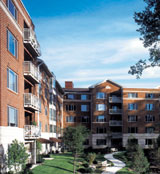 Where There’s Smoke, There’s Fire
Where There’s Smoke, There’s Fire. And, too often, they result in loss of property, injury, and death. Fires in apartments, condominiums, hotels, motels, dormitories, and assisted living/nursing homes destroy property and disrupt lives; they also disfigure, disable, and kill. Is there a way to protect ourselves and our families, our homes, and cherished possessions from fire’s devastating effects? The non-combustible concrete construction industries have long advocated balanced design for property protection and life safety. Balanced design combines active systems (fire detection and suppression) with passive containment and control through the use of non-combustible fire-resistive walls, floors, and roofs.
Building Construction Has Changed
Over the last 30 years, promotion of active systems—sprinklers—has resulted in compromises in building construction materials to offset increased costs associated with these systems. Dare we depend solely on suppression devices to fight fire and save lives? The latest information from the United States Fire Incidence Reporting System (USFIRS) suggests not.
Fire Statistics (1,2) During the 1990s, the number of deaths, injuries, and property damage reported per fire incidence in apartments remained fairly constant, despite increased use of active systems. This statistical stagnation— rather than improvement—is most likely the result of a recent trend in building codes to require automatic fire suppression systems while simultaneously reducing or eliminating compartmentation requirements.
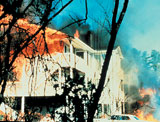 Who’s at Risk? We are all vulnerable to the ravages of fire. But at greater risk are people who cannot respond or evacuate in time. Infants and children, people with hearing or visual impairments, and people with mental and physical disabilities. The United States Fire Administration (3) is concerned about housing the elderly, the fastest growing segment of the population. Adults age 65 to 75 have a fire death rate of twice the national average; 75 to 85, three times the average; and over 85, four times the average. Our nation’s senior citizens suffer vision, hearing, and mobility impairment, with 82 percent of those over 65 categorized as significantly disabled. And the steady rise in the U.S. elderly population is projected to continue— peaking around 2020. Current methods to alert seniors of fire and afford evacuation time are inadequate. We need to assure that structures built today incorporate comprehensive balanced design to protect these precious individuals—our parents and grandparents—from the rapid spread of fire.
Who’s at Risk? We are all vulnerable to the ravages of fire. But at greater risk are people who cannot respond or evacuate in time. Infants and children, people with hearing or visual impairments, and people with mental and physical disabilities. The United States Fire Administration (3) is concerned about housing the elderly, the fastest growing segment of the population. Adults age 65 to 75 have a fire death rate of twice the national average; 75 to 85, three times the average; and over 85, four times the average. Our nation’s senior citizens suffer vision, hearing, and mobility impairment, with 82 percent of those over 65 categorized as significantly disabled. And the steady rise in the U.S. elderly population is projected to continue— peaking around 2020. Current methods to alert seniors of fire and afford evacuation time are inadequate. We need to assure that structures built today incorporate comprehensive balanced design to protect these precious individuals—our parents and grandparents—from the rapid spread of fire.
Balanced Design for life safety and property protection is a combination of three key elements: smoke detection, fire suppression, and compartmentation to provide for fire containment. Construction incorporating all three components provides valuable backup in the event of active system failure, a fairly common occurrence. Balanced design should be the standard in all multi-family homes. Recent building code changes adopted at the expense of compartmentation should be reconsidered with fire sprinkler systems deemed adjuncts to fire-safe construction. Without provisions for balanced design in building codes, responsibility is placed on owners or state and local officials to demand or designers to recommend that adequate fire safety be incorporated into multi-family homes.

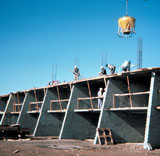
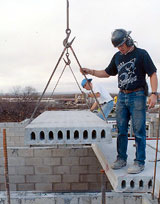
Options for non-combustible concrete construction include cast-in-place and hollow-core precast concrete floors, ceilings, and roofs; and cast-in place concrete, precast concrete, or concrete masonry walls.
Fire Containment with walls, floors, and ceilings limits the area of fire spread and provides a last line of defense should sprinklers fail. To be effective, walls and floors/ceilings providing compartmentation should be of non-combustible construction with at least two hours of fire resistance. Non-combustible concrete and masonry walls and floors do not produce smoke or generate toxic fumes. They are always at the ready providing passive fire containment and protecting life and property, while affording firefighters more time to safely focus their efforts on extinguishing a blaze rather than containing it. Options for non-combustible concrete construction include cast-in-place and hollow-core precast concrete floors, ceilings, and roofs; and cast-in place concrete, precast concrete, or concrete masonry walls.
Smoke Detection systems are primarily intended to provide early warning of a fire, giving occupants time to evacuate a building safely. However, recent figures (4) show that 31 percent of apartment fire deaths occurred in buildings where smoke detectors were present and in working order. (See Table 2.) Nineteen percent of the deaths occurred in buildings where smoke detectors were present but inoperable—virtually no improvement since 1996, when the percentages were 30 percent and 18 percent, respectively. The grim and unchanging reality is that 50 percent of apartment fire deaths occur even when smoke detectors are present.
Fire Suppression systems are primarily intended to control fires until the fire service arrives. In some cases sprinklers will extinguish a fire. The National Fire Protection Association (NFPA) 13R standard—which governs the installation of sprinkler systems in residential buildings up to and including four stories—does not require all areas to be sprinklered, including combustible concealed spaces such as floor/ceiling assemblies and attics. If a fire originates in an unsprinklered space it is not likely to be controlled, and considerable property damage or total destruction may occur; even worse is the increased possibility of injury or loss of life. Diligent maintenance that must continue throughout the life of the structure is required to assure proper system functioning. Even then, sprinklers may be out of service during maintenance or may fail due to water outages or system glitches.
Non-Combustible Concrete Construction. To achieve true balanced design and reduce deaths, injuries, and property loss, the multi-family building community should consider non-combustible concrete construction. Various affordable products and systems exist to satisfy design requirements and fire resistance ratings. Options include cast-in-place or hollow-core precast concrete floors, ceiling, and roofs; and cast-in-place concrete, precast concrete, or concrete masonry walls. Non-combustible concrete construction benefits occupants, owners, and communities alike.
What to Do. When renting or buying a home in a multi-family building, lodging overnight away from home, or housing loved ones in dormitories or nursing facilities, consider buildings that provide all three components of balanced design. Look for smoke detectors, sprinkler systems, and ask if walls, floors, and roofs are of concrete construction. Urge local building code officials to assure that multi-family homes are constructed using all three components of balanced fire-safe design, including the critical component: non-combustible concrete construction.
Look for the Three Key Elements of Balanced Design
- Smoke detection
- Fire suppression
- Compartmentation to provide for fire containment
Containment Story #1
Dormitory Fire Contained
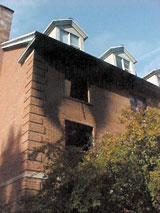
On October 11, 2001, fire engulfed the Rees Hall Dormitory at Hobart and William Smith Colleges in Geneva, New York. Temperatures as high as 1,800 degrees Fahrenheit melted plastic picture frames, light fixtures, and smoke detectors, outside the room and warped metal hinges and the steel door of the room where the fire started. In just 20 minutes, the raging fire caused about $100,000 of damage—a small repair bill, considering that concrete construction saved the building from being completely destroyed.
Originally constructed in 1969 with concrete masonry and hollow-core floor planks, the building is “durable and fire resistant “and has much lower maintenance and insurance costs.”,” said Christopher J. Button, senior project manager, Hobart and William Smith Colleges. Replacing the entire structure would have cost as much as $5 million.
Button said he’d always believed any building with a smoke detector and non-combustible materials would withstand similar catastrophes, but after seeing how concrete stood up to the intense fire, he’s “a believer in concrete construction.”
Containment Story #2
Balanced Design Saves Perry Hall
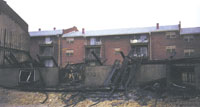 In Baltimore, Maryland, concrete masonry saved the Perry Hall Apartments from complete destruction. When the building was under construction, an arsonist doused it with gasoline and burned an 80-by- 40-foot wood-frame section to the ground. The rest of the building was salvaged because the concrete masonry fire wall contained the blaze.
In Baltimore, Maryland, concrete masonry saved the Perry Hall Apartments from complete destruction. When the building was under construction, an arsonist doused it with gasoline and burned an 80-by- 40-foot wood-frame section to the ground. The rest of the building was salvaged because the concrete masonry fire wall contained the blaze.
Concluded Tony Mazzella, superintendent with Perry Hall builder Mark Hall & Company: “If all the walls were of wood frame and gypsum board everything would have had to be replaced. The entire building would have burned to the ground.”
Containment Story #3
Quality Construction: A Concrete Plus
For Baltimore builder James Keelty & Company, concrete provides more than fire safety. It contributes to the firm’s reputation as a quality builder producing of multi-family residences. “A combination of factors goes into our use of concrete masonry. There is both a perception and the reality of it being a quality building, from both the fire resistance and sound transmission aspects, where concrete performs very well.” said Steve James, Keelty vice president.
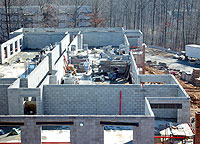
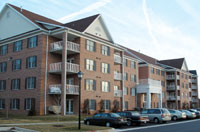
Robert W. Bertazon – Masonry Institute of Maryland, Inc.
References
1 Fire in the United States 1987-1996, Eleventh Edition, United States Fire Administration, National Fire Data Center, Emmitsburg, Maryland, August 1999.
2 Fire in the United States 1989-1998, Twelfth Edition, United States Fire Administration, National Fire Data Center, Emmitsburg, Maryland, November 2001.
3 Fire Risks for Older Adults, United States Fire Administration, National Fire Data Center, Emmitsburg, Maryland, October 1999.
4 A Profile of Fire in the United States 1989-1998, Twelfth Edition, United States Fire Administration, National Fire Data Center, Emmitsburg, Maryland, August 2001.